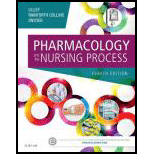
To review:
The concepts related to carcinogenesis, the types of malignancies and related terminology, and the different treatment modalities, including the use of cell-cycle-nonspecific and miscellaneous antineoplastic drugs.
Introduction:
Antineoplastic drugs are medications that are used in the treatment of cancer. They are also known as anticancer drugs otherwise cytotoxic or hazardous drugs. These drugs are most commonly used in chemotherapy. Antineoplastic drugs are available in many forms. Some drugs are given through injections and some are administered as pills.
Explanation of Solution
Carcinogenesis otherwise known as oncogenesis is the development of cancer, in which normal cells are transformed into tumor cells. Oncogenesis process is characterized by changes in the cellular, epigenetic and genetic levels as well as unusual cell division. Both natural and chemical substances that can lead to cancer are called as carcinogens. Not all the cancers occur as a result of DNA alterations, some occur as a result of the abnormal division of cells at a rapid rate.
The risk factors that are associated with the cause of cancer are smoking and tobacco, age, diet, cancer-causing substances, infectious agents (virus), hormones, radiations (sun and chemical), and suppressed immune system.
The major types of cancer are sarcoma (cancer in connective tissue), lymphoma (cancer in lymphocytes), melanoma (cancer in the skin), carcinoma (cancer developed from epithelial cells), and leukemia (cancer in white blood cells).
Some of the important terminology related to cancer is given below:
Neoplasm: Formation of abnormal tissue is known as a neoplasm.
Benign tumor: Tumor that is malignant and reversible to a normal state.
Malignant: Uncontrolled or self-limiting growth of cancerous cells. Can invade into nearby tissues.
Metastasis: The process of spread of cancer or tumor cells from the primary site to various sites or secondary site is known as metastasis.
Cancer can be treated by one of the following methods:
- Synthetic lethality
- Chemotherapy
- Radiation therapy
- Surgery
- Targeted cell therapy
Non-hematological tumors can be cured by surgery, however, it is not always possible. Ionizing radiations are used to kill or shrink the cancerous cells in radiation therapy. Ovarian and colon cancers are treated by synthetic lethality. Targeted therapy involves small molecules that target the deregulated proteins in the cell-matrix surrounding the tumor cells. Useful in the treatment of cancers (some types). Chemotherapy refers to the application or use of cytotoxic drugs, hormonal and miscellaneous drugs for treating various cancers. Antineoplastic drugs are medications are used in the treatment of cancer. They are also known as anticancer drugs otherwise cytotoxic or hazardous drugs.
Cell-cycle-nonspecific drugs are divided into two major categories. They are alkylating agents and antibiotics. These drugs are effective for low-grade solid tumor cells and fraction malignancies with high growth. Common examples of the alkylating agents are cyclophosphamide and cisplatin. Common examples of antibiotics are bleomycin, doxorubicin, and mitomycin.
Hormonal drugs (agonists and antagonists) are agents that interfere with hormone balance in the body. Common examples are adrenal corticosteroids, estrogens, and tamoxifen. They are used in the treatment of various malignancies. Drugs that belong to the miscellaneous category have different chemical structures and mode of action when compared with other antineoplastic drugs. Some examples are hydroxyurea, mitotane, sorafenib, hormonal and radioactive drugs. Some of these drugs are administered orally and some by intravenous mode. Used in the treatment of prostate cancer. Infusion-related effects and serious side effects such as hepatotoxicity, QT prolongation may occur while using these drugs. A drug interaction occurs with grapefruit juice, conivaptan, CYP3A4 inducers, and inhibitors.
The concepts related to carcinogenesis, the types of malignancies and related terminology, and the different treatment modalities, including the use of cell-cycle-nonspecific and miscellaneous antineoplastic drugs are explained.
Want to see more full solutions like this?
Chapter 46 Solutions
Pharmacology and the Nursing Process, 8e
 Phlebotomy EssentialsNursingISBN:9781451194524Author:Ruth McCall, Cathee M. Tankersley MT(ASCP)Publisher:JONES+BARTLETT PUBLISHERS, INC.
Phlebotomy EssentialsNursingISBN:9781451194524Author:Ruth McCall, Cathee M. Tankersley MT(ASCP)Publisher:JONES+BARTLETT PUBLISHERS, INC. Gould's Pathophysiology for the Health Profession...NursingISBN:9780323414425Author:Robert J Hubert BSPublisher:Saunders
Gould's Pathophysiology for the Health Profession...NursingISBN:9780323414425Author:Robert J Hubert BSPublisher:Saunders Fundamentals Of NursingNursingISBN:9781496362179Author:Taylor, Carol (carol R.), LYNN, Pamela (pamela Barbara), Bartlett, Jennifer L.Publisher:Wolters Kluwer,
Fundamentals Of NursingNursingISBN:9781496362179Author:Taylor, Carol (carol R.), LYNN, Pamela (pamela Barbara), Bartlett, Jennifer L.Publisher:Wolters Kluwer, Fundamentals of Nursing, 9eNursingISBN:9780323327404Author:Patricia A. Potter RN MSN PhD FAAN, Anne Griffin Perry RN EdD FAAN, Patricia Stockert RN BSN MS PhD, Amy Hall RN BSN MS PhD CNEPublisher:Elsevier Science
Fundamentals of Nursing, 9eNursingISBN:9780323327404Author:Patricia A. Potter RN MSN PhD FAAN, Anne Griffin Perry RN EdD FAAN, Patricia Stockert RN BSN MS PhD, Amy Hall RN BSN MS PhD CNEPublisher:Elsevier Science Study Guide for Gould's Pathophysiology for the H...NursingISBN:9780323414142Author:Hubert BS, Robert J; VanMeter PhD, Karin C.Publisher:Saunders
Study Guide for Gould's Pathophysiology for the H...NursingISBN:9780323414142Author:Hubert BS, Robert J; VanMeter PhD, Karin C.Publisher:Saunders Issues and Ethics in the Helping Professions (Min...NursingISBN:9781337406291Author:Gerald Corey, Marianne Schneider Corey, Cindy CoreyPublisher:Cengage Learning
Issues and Ethics in the Helping Professions (Min...NursingISBN:9781337406291Author:Gerald Corey, Marianne Schneider Corey, Cindy CoreyPublisher:Cengage Learning





